Founded 1957 | Nickname(s) USFJ | |
 | ||
Profiles | ||
The United States Forces Japan (USFJ) (在日米軍, Zainichi Beigun) is an active subordinate unified command of the United States Pacific Command (USPACOM). It was activated at Fuchū Air Station, Tokyo, Japan on 1 July 1957 to replace the Far East Command (FEC). USFJ is commanded by the Commander, U.S. Forces, Japan (COMUSJAPAN). COMUSJAPAN is also the Commander, Fifth Air Force. At present, USFJ is headquartered at Yokota Air Base, Tokyo, Japan.
Contents
- History
- Exercise participation
- US presence on Okinawa
- Survey among Japanese and Okinawans
- Status of forces agreement
- US service member behavior
- Crime issues
- Osprey deployment in Okinawa
- List of current facilities
- List of former facilities
- References
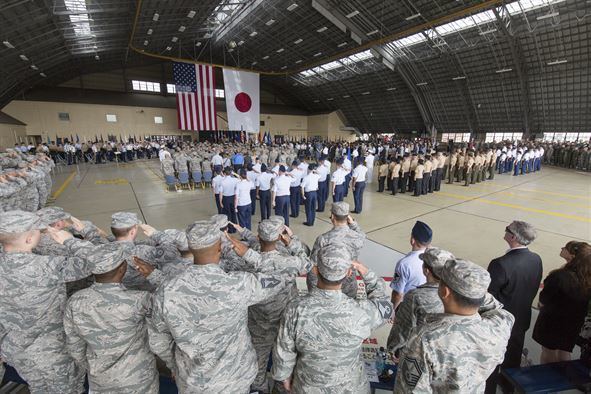
COMUSJAPAN, plans, directs and supervises the execution of missions and responsibilities assigned to him by the U.S. Commander in Chief, Pacific (USCINCPAC). He establishes and implements policies to accomplish the mission of the United States Armed Forces in Japan. He is responsible for developing plans for the defense of Japan, and he must be prepared if contingencies arise, to assume operational control of assigned and attached U.S. forces for the execution of those plans.
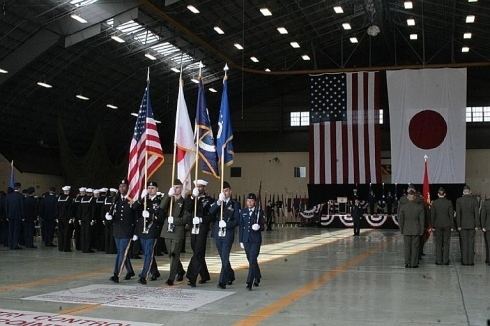
As USCINCPAC's resident representative, COMUSJAPAN supports the Security Treaty and administers the Status of Forces Agreement (SOFA) between the United States and Japan. He is responsible for coordinating various matters of interest with the service commanders in Japan. These include matters affecting US-Japan relationships among and between Department of Defense (DOD) agencies; DOD agencies and the U.S. Ambassador to Japan; and DOD agencies and the Government of Japan (GOJ).
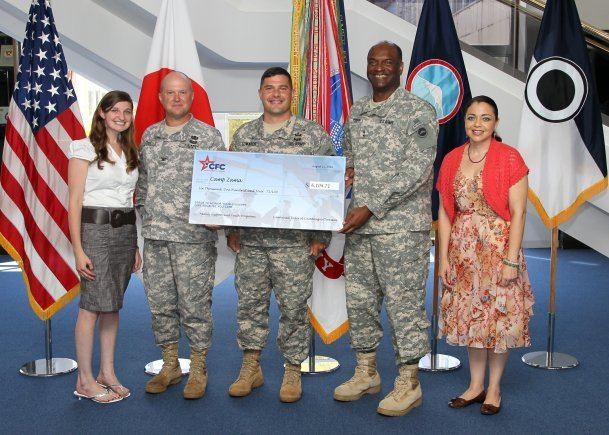
Under the Treaty of Mutual Cooperation and Security between the United States and Japan, the United States is obliged to protect Japan in close cooperation with the Japan Self-Defense Forces for maritime defense, ballistic missile defense, domestic air control, communications security (COMSEC) and disaster response operations.
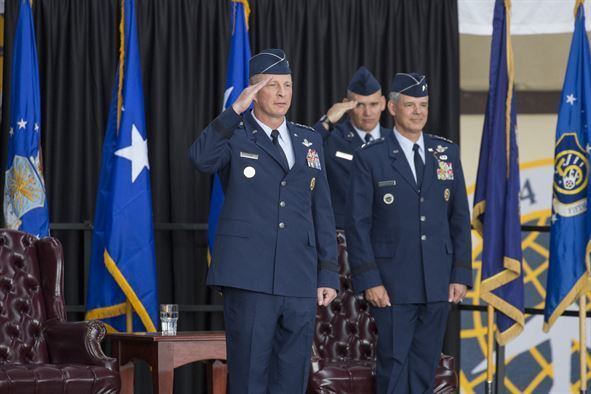
History
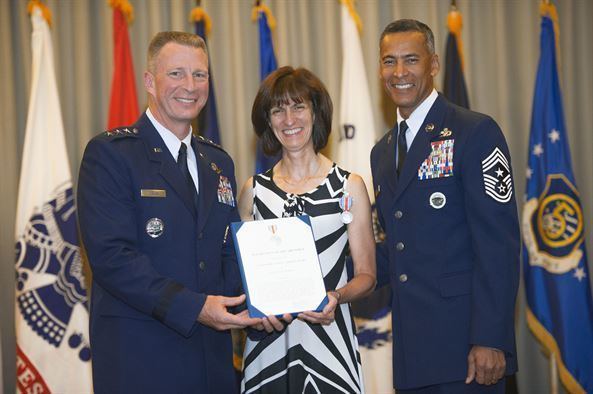
After the Japanese surrender in the end of World War II in Asia, the United States Armed Forces assumed administrative authority in Japan. The Japanese Imperial Army and Navy were decommissioned, and the U.S. Armed Forces took control of their military bases until the new government could be formed and positioned to reestablish authority. Allied forces planned to demilitarize Japan, and new government adopted the Constitution of Japan with a no-armed-force clause in 1947.

After the Korean War began in 1950, Douglas MacArthur, the Supreme Commander for the Allied Powers in Japan and the Japanese government established the paramilitary "National Police Reserve," which was later developed into the Japan Self-Defense Forces.
In 1951 the Treaty of San Francisco was signed by the allied countries and Japan, which restored its formal sovereignty. At the same time, the U.S. and Japan signed the Japan-America Security Alliance. By this treaty, USFJ is responsible for the defense of Japan. As part of this agreement, the Japanese government requested that the U.S. military bases remain in Japan, and agreed to provide funds and various interests specified in the Status of Forces Agreement. At the expiration of the treaty, the United States and Japan signed the new Treaty of Mutual Cooperation and Security between the United States and Japan. The status of the United States Forces Japan was defined in the U.S.–Japan Status of Forces Agreement. This treaty is still in effect, and it forms the basis of Japan's foreign policy.
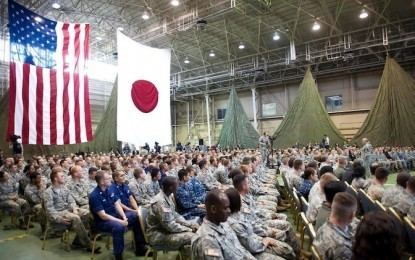
In the Vietnam War, the US military bases in Japan, especially those in Okinawa Prefecture, were used as important strategic and logistic bases. In 1970, Koza riot occurred against the US military presence in Okinawa. The USAF strategic bombers were deployed in the bases in Okinawa, which was still administered by the U.S. government. Before the 1972 reversion of the island to Japanese administration, it has been speculated but never confirmed that up to 1,200 nuclear weapons may have been stored at Kadena Air Base, Okinawa in the 1960s.
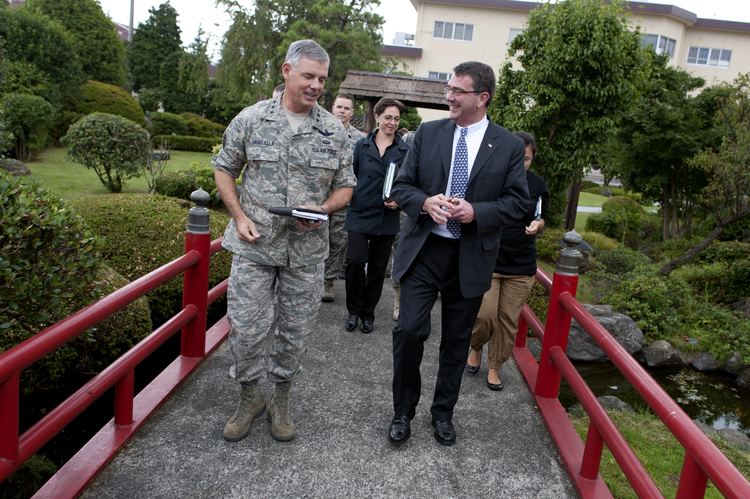
As of 2013, there are approximately 50,000 U.S. military personnel stationed in Japan, along with approximately 40,000 dependents of military personnel and another 5,500 American civilians employed there by the United States Department of Defense. The United States Seventh Fleet is based in Yokosuka, Kanagawa Prefecture. The 3rd Marine Expeditionary Force (III MEF) is based in Okinawa. 130 USAF fighters are stationed in the Misawa Air Base and Kadena Air Base.
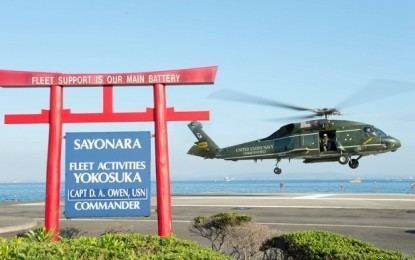
The Japanese government paid ¥217 billion (US$2.0 billion) in 2007 as annual host-nation support called Omoiyari Yosan (思いやり予算, sympathy budget or compassion budget). As of the 2011 budget, such payment was no longer to be referred to as Omoiyari Yosan or sympathy budget.
The U.S. government employs over 8,000 Master Labor Contract (MLC)/Indirect Hire Agreement (IHA) workers on Okinawa (per the Labor Management Organization) not including Okinawan contract workers.
Immediately after the 2011 Tōhoku earthquake and tsunami, 9,720 dependents of United States military and government civilian employees in Japan evacuated the country, mainly to the United States.
The relocation of the U.S. Marine Corps Air Station Futenma to Henoko had been resolved in December 2013 with the signing of the landfill agreement by the governor of Okinawa. Under the terms of the U.S.-Japan agreement 5.000 U.S. Marines should have been relocated to Guam and 4.000 U.S. Marines to other Pacific locations such as Hawaii or Australia, while some 10.000 Marines were to remain on Okinawa. No timetable for the Marines redeployment had been announced, but The Washington Post reported that U.S. Marines would leave Okinawa as soon as suitable facilities on Guam and elsewhere were ready. The relocation move was expected to cost 8.6 billion US Dollars and includes a $3.1bn cash commitment from Japan for the move to Guam as well as for developing joint training ranges on Guam and on Tinian and Pagan in the Commonwealth of the Northern Mariana Islands. Certain parcels of land on Okinawa which have been leased for use by the American military were supposed to be turned back to Japanese control via a long-term phased return process according to the agreement. These returns have been ongoing since 1972. However, as of July 2016, the situation has not been settled.
In May 2014, in a strategic shift by the United States to Asia and the Pacific, it was revealed the US was deploying two unarmed Global Hawk long-distance surveillance drones to Japan for surveillance missions over China and North Korea.
Exercise participation
The scope and frequency of U.S. Forces Japan participation in major exercises has been rising in recent years. This is largely attributable to the refocus of the U.S. to the Asia-Pacific region, although certain forces, especially the Marine Corps, have never left the region and continue to be heavily involved in theater security and regional stability. United States Pacific Command (USPACOM), the parent command of U.S. Forces Japan, has also taken on larger and broader roles during exercises in Japan, particularly in those exercises on mainland Japan.
U.S. Forces Japan has no control or authority over subordinate command exercises beyond manipulation of Force Protection Condition levels, which is the only area of tactical control residing with U.S. Forces Japan.
U.S. presence on Okinawa
Okinawa makes up only 0.6 percent of the nation's land area; yet, approximately 62% of U.S. bases in Japan (exclusive use only) are in Okinawa.
Survey among Japanese and Okinawans
While 73.4% of Japanese citizens appreciate the mutual security treaty with the U.S. and the presence of the USFJ, part of the population demands a reduction in the number of U.S. military bases in Okinawa.
In May 2010, a survey of the Okinawan people conducted by the Mainichi Shimbun and the Ryūkyū Shimpō, found that 71% of Okinawans surveyed thought that the presence of Marines on Okinawa was not necessary (15% said it was necessary.). Asked what they thought about 62% of United States Forces Japan bases (exclusive use) being concentrated in Okinawa, 50% said that the number should be reduced, 41% said that the bases should be removed. Asked about the US-Japan security treaty, 55% said it should be changed to a peace treaty, 14% said it should be abolished and 7% said it should be maintained.
Many of the bases, such as Yokota Air Base, Naval Air Facility Atsugi and Kadena Air Base, are located in the vicinity of residential districts, and local citizens have complained about excessive aircraft noise. The 2014 poll by Ryūkyū Shimpō found that 80% of surveyed Okinawans want the Marine Corps Air Station Futenma moved out of the prefecture.
Status of forces agreement
There is also debate over the Status of Forces Agreement due to the fact that it covers a variety of administrative technicalities blending the systems which control how certain situations are handled between the U.S.'s and Japan's legal framework. A Status of forces agreement was created to allow both nations the best way to administer legalities, and has worked well over the years.
U.S. service member behavior
Per Okinawa Prefectural Police data, U.S. service members are convicted of far fewer crimes than local Okinawans. According to the U.S.-Japan Status of Forces Agreement, when U.S. personnel crimes are committed both off-duty and off-base, they should always be prosecuted under the Japanese law.
On 12 February 2008, the National Police Agency (of Japan) or NPA, released its annual criminal statistics that included activity within the Okinawan prefecture. These findings held American troops were only convicted of 53 crimes per 10,000 U.S. male servicemen, while Okinawan males were convicted of 366 crimes per 10,000. The crime rate found a U.S. serviceman in Okinawa to be 86% less likely to convicted of a crime by the Japanese government than an Okinawan male.
Crime issues
At the beginning of the occupation of Japan, in 1945, many U.S. soldiers participated in the Special Comfort Facility Association. Japanese government recruited 55,000 women to work providing sexual services to US military personnel. The Association was closed by the Supreme Commander for the Allied Powers.
In more recent history, 'crimes ranging from rape to assault and hit-and-run accidents by U.S. military personnel, dependents and civilians have long sparked protests in the prefecture.', stated The Japan Times 'A series of horrific crimes by present and former U.S. military personnel stationed on Okinawa has triggered dramatic moves to try to reduce the American presence on the island and in Japan as a whole', commented The Daily Beast in 2009.
In 1995, the abduction and rape of a 12-year-old Okinawan schoolgirl by two U.S. marines and one U.S. sailor led to demands for the removal of all U.S. military bases in Japan. Other controversial incidents include helicopter crashes, the Girard incident, the Michael Brown Okinawa assault incident, the death of Kinjo family and the death of Yuki Uema. In February 2008, a 38-year-old U.S. Marine based on Okinawa was arrested in connection with the reported rape of a 14-year-old Okinawan girl. This triggered waves of protest against American military presence in Okinawa and led to tight restrictions on off-base activities. Although the accuser withdrew her charges the U.S. military court-martialed the suspect and sentenced him to 4 years in prison under the stricter rules of the military justice system.
U.S. Forces Japan designated 22 February as a Day of Reflection for all U.S. military facilities in Japan, and established the Sexual Assault Prevention and Response Task Force in an effort to prevent similar incidents. In November 2009, Staff Sgt. Clyde "Drew" Gunn, a U.S. Army soldier stationed at Torii Station was involved in a hit-and-run accident of a pedestrian in Yomitan Village on Okinawa. Later, in April 2010, the soldier was charged with failing to render aid and vehicular manslaughter. Staff Sgt. Gunn, of Ocean Springs, Mississippi, was eventually sentenced to 2 years and 8 months in jail on 15 October 2010.
In 2013, two U.S. military personnel, Seaman Christopher Browning, of Athens, Texas, and Petty Officer 3rd Class Skyler Dozierwalker, of Muskogee, Oklahoma, were found guilty by the Naha District Court of raping and robbing a woman in her 20s in a parking lot in October. Both admitted committing the crime. The case outraged many Okinawans, a number of whom have long complained of military-related crime on their island, which hosts thousands of U.S. troops. It also sparked tougher restrictions for all 50,000 U.S. military personnel in Japan, including a curfew and drinking restrictions.
On 13 May 2013, in a very controversial statement, Toru Hashimoto, co-leader of the Japan Restoration Association said to a senior American military official at the Marine Corps base in Okinawa "We can’t control the sexual energy of these brave marines." and told United States soldiers should make more use of the local adult entertainment industry to reduce sexual crimes against local women. Hashimoto also told the necessity of former Japanese Army comfort women and of prostitutes for the US military in other countries such as Korea.
In June 2016, after a civilian worker at the base was charged with murdering a Japanese woman, tens of thousands of people protested in Okinawa. Organizers estimated turnout at 65,000 people, which would be the largest anti-base protests in Okinawa since 1995.
Osprey deployment in Okinawa
In October 2012, twelve MV-22 Ospreys were transferred to the US Marine Corps Air Station Futenma to replace aging Vietnam-era Boeing Vertol CH-46 Sea Knight helicopters in Okinawa, greatly increasing the safety, capability and range of the Marines who are charged with Japan's defense as well as regional security. Then in October 2013, an additional 12 Ospreys arrived, again to replace CH-46 Sea Knights, increasing the number of Ospreys to 24. Japanese Defence Minister Satoshi Morimoto explained the Osprey aircraft is safe adding that two recent accidents were 'caused by human factors'. Japanese Prime Minister Yoshihiko Noda also stated that the Japanese government was convinced of the MV-22's safety.
List of current facilities
The USFJ headquarters is at Yokota Air Base, about 30 km west of central Tokyo.
The U.S. military installations in Japan and their managing branches are as follows:
JSDF-USFJ Joint Use Facilities and Areas
Temporary use facilities and areas are as follows:
In Okinawa, U.S. military installations occupy about 10.4 percent of the total land usage. Approximately 74.7 percent of all the U.S. military facilities in Japan are located on the island of Okinawa.
List of former facilities
The United States has returned some facilities to Japanese control. Some are used as military bases of the JSDF; others have become civilian airports or government offices; many are factories, office buildings or residential developments in the private sector. Due to the Special Actions Committee on Okinawa, more land in Okinawa is in the process of being returned. These areas include—Camp Kuwae [also known as Camp Lester], MCAS Futenma, areas within Camp Zukeran [also known as Camp Foster], about 9,900 acres (40 km2) of the Northern Training Area, Aha Training Area, Gimbaru Training Area (also known as Camp Gonsalves), small portion of the Makiminato Service Area (also known as Camp Kinser), and Naha Port.
Army:
Navy:
Air Force:
Marines:
